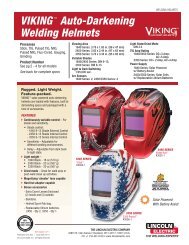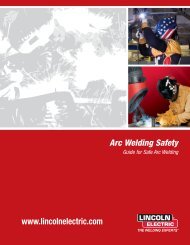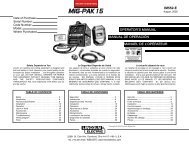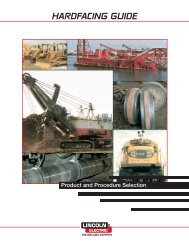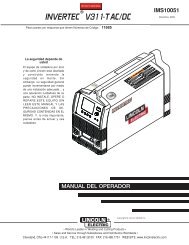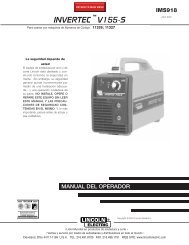Consumeables Catalog - Lincoln Electric
Consumeables Catalog - Lincoln Electric
Consumeables Catalog - Lincoln Electric
You also want an ePaper? Increase the reach of your titles
YUMPU automatically turns print PDFs into web optimized ePapers that Google loves.
WARNING<br />
FUMES & GASES can be dangerous to your health<br />
• Keep fumes and gases from your<br />
breathing zone and general area.<br />
• Keep your head out of the fumes.<br />
• Use enough ventilation or exhaust at the<br />
arc, or both, to keep fumes and gases from<br />
your breathing zone and general area.<br />
Fumes and Gases<br />
Because of the variables involved in fume and gas<br />
generation from arc welding, cutting and allied processes<br />
(such as the welding process and electrode, the base<br />
metal, coatings on the base metal, and other possible<br />
contaminants in the air), we’ll have to treat the subject in<br />
a rather general way, lumping all but the more hazardous<br />
situations together. The precautions we describe will hold<br />
true for all arc welding processes.<br />
The fume plume contains solid particles from the<br />
consumables, base metal, and base metal coating.<br />
For common mild steel arc welding, depending on the<br />
amount and length of exposure to these fumes, most<br />
immediate or short term effects are temporary, and<br />
include symptoms of burning eyes and skin, dizziness,<br />
nausea, and fever. For example, zinc fumes can cause<br />
metal fume fever, a temporary illness that is similar<br />
to the flu.<br />
Long-term exposure to welding fumes can lead to<br />
siderosis (iron deposits in the lungs) and may affect<br />
pulmonary function. Bronchitis and some lung fibrosis<br />
have been reported.<br />
Some consumables contain certain compounds in amounts<br />
which may require special ventilation and/or exhaust.<br />
These Special Ventilation products can be identified by<br />
reading the labels on the package. If Special Ventilation<br />
products are used indoors, use local exhaust. If Special<br />
Ventilation products are used outdoors, a respirator may<br />
be required. Various compounds, some of which may be<br />
in welding fume, and reported health effects, in summary, are:<br />
Barium: Soluble barium compounds may cause severe<br />
stomach pain, slow pulse rate, irregular heart beat,<br />
ringing of the ears, convulsions and muscle spasms. In<br />
extreme cases can cause death.<br />
Cadmium also requires extra precautions. This toxic<br />
APPENDIX<br />
Safety Guidelines<br />
Safety Practices in Welding<br />
metal can be found on some steel and steel fasteners<br />
as a plating, or in silver solder. Cadmium fumes can<br />
be fatal even under brief overexposures, with symptoms<br />
much like those of metal fume fever. These two conditions<br />
should not be confused. Overexposure to cadmium can<br />
be enough to cause fatalities, with symptoms appearing<br />
quickly, and, in some circumstances, death a few days later.<br />
Chromium: Chromium is on the IARC (International Agency<br />
for Research on Cancer) and NTP (National Toxicology<br />
Program) lists chromium as posing a carcinogenic risk to<br />
humans. Fumes from the use of stainless steel, hardfacing<br />
and other types of consumables contain chromium and/<br />
or nickel. Some forms of these metals are known or<br />
suspected to cause lung cancer in processes other than<br />
welding and asthma has been reported. Therefore, it<br />
is recommended that precautions be taken to keep<br />
exposures as low as possible. OSHA recently adopted a<br />
lower PEL (Permissible Exposure Limit) for chromium<br />
(see Supplement 3). The use of local exhaust and/or an<br />
approved respirator may be required to avoid overexposure.<br />
Coatings on the metal to be welded, such as paint, may<br />
also contain toxic substances, such as lead, chromium<br />
and zinc. In general, it is always best to remove coatings<br />
from the base metal before welding or cutting.<br />
Cobalt: Exposure to cobalt can cause respiratory disease<br />
and pulmonary sensitization. Cobalt in metallic form has<br />
been reported to cause lung damage.<br />
Copper: Prolonged exposure to copper fume may cause<br />
skin irritation or discoloration of the skin and hair.<br />
Manganese: Manganese overexposure may affect the<br />
central nervous system, resulting in poor coordination,<br />
difficulty in speaking, and tremor of arms or legs. This<br />
condition is considered irreversible.<br />
Nickel: Nickel and its compounds are on the IARC<br />
(International Agency for Research on Cancer) and NTP<br />
(National Toxicology Program) lists as posing a<br />
carcinogenic risk to humans.<br />
Silica: Crystalline silica is present in respirable dust form<br />
submerged arc flux. Overexposure can cause severe lung<br />
damage (silicosis).<br />
Zinc: Overexposure to zinc (from galvanized metals) may<br />
cause metal fume fever with symptoms similar to the<br />
common flu.<br />
WELDING CONSUMABLES CATALOG ı 409



